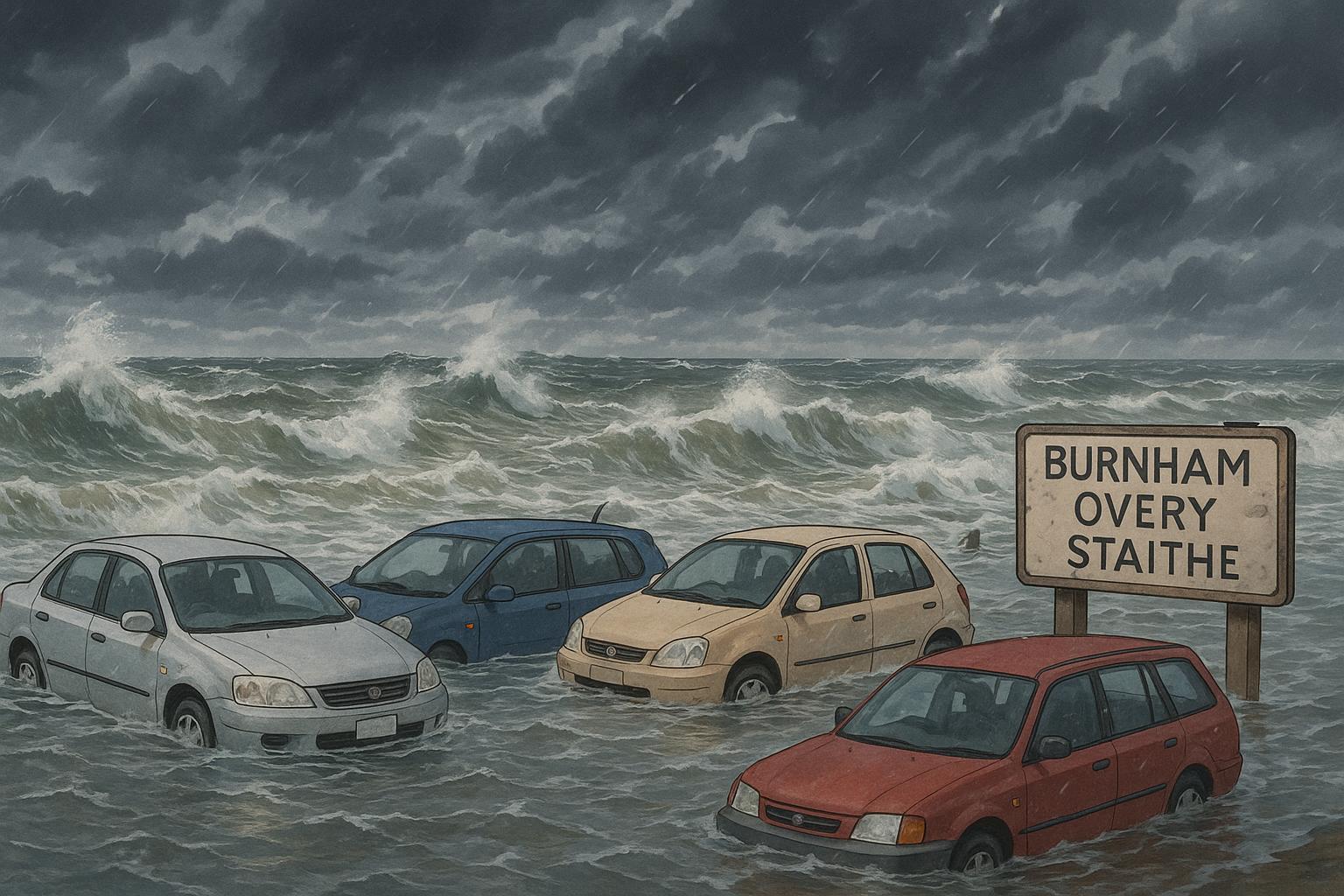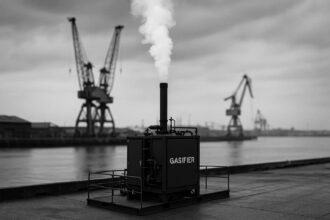At least six vehicles were submerged during a Bank Holiday at Burnham Overy Staithe due to a rare combination of Spring Tides and strong winds, amid rising concerns over record dry spring conditions and escalating coastal flood risks in Norfolk.
Drivers faced a frustrating predicament over the Bank Holiday as several cars were swept into the sea at Burnham Overy Staithe, a popular coastal destination in Norfolk. This unfortunate incident coincided with a series of high tides exacerbated by strong winds, resulting in at least six vehicles becoming submerged. The combination of the monthly Spring Tide, which aligns with the new moon, and gusty weather conditions contributed to water levels rising rapidly, leaving some motorists unable to reach their cars in time. While most managed to salvage their vehicles, two cars were swept away entirely, with one later retrieved but reportedly with a flooded engine.
The chaos of the situation was heightened by the fact that it coincided with special racing events organised by the Royal National Lifeboat Institution (RNLI) at nearby Brancaster Staithe. Though locals are generally aware of the precarious nature of coastal conditions, some visitors often underestimate the rapidly shifting tides, leading to vehicles being left too close to the water’s edge during their outings to enjoy the picturesque surroundings or have a meal in local pubs.
Recent weather patterns have played a significant role in shaping the current coastal conditions. High winds contributing to lower pressure systems have increased tides by an estimated 40cm over the weekend. Meteorologists from the Met Office have warned that further gusts are expected, posing a continued risk to vehicles parked near the shore. The effects of recent storms, including Storm Kathleen, have been felt across the region, leading to pronounced tidal surges and the issuance of flood warnings from the Environment Agency. Residents had been advised to relocate their vehicles to higher ground in anticipation of severe flooding conditions.
Interestingly, this year has been marked by a dry spell across much of the UK following an unusually dry start to spring, which some meteorologists believe could lead to drought conditions later in the summer. With rainfall figures falling below historical averages—only 80.6mm recorded as of mid-May—the UK is on track to possibly set a record for the driest spring ever, a significant observation given that the previous record was set nearly 170 years ago. The Met Office has attributed this dryness to persistent high-pressure systems, often lingering over the UK since February. Such weather patterns have not only impacted regional coastal dynamics but also raised concerns among farmers about potential crop failures due to insufficient rainfall.
Additionally, East Anglia’s farming community has expressed worry over the implications of the low rainfall. As a representative for the National Farmers’ Union remarked, the dry conditions could lead to concerning consequences for food production, compounding existing pressures on water resources. The Environment Agency is also urging water companies to enhance their management strategies to mitigate the risks posed by summer droughts.
Furthermore, coastal areas like Burnham Overy Staithe are particularly sensitive to flooding, having faced issues of coastal erosion and increased flood risks in the past. Last year, it was reported that a stretch of beach nearby had reached a ‘trigger point’ for erosion, amplifying the urgency for preventive measures to protect local infrastructure and property. This has led to warnings from the Environment Agency about the critical need to refrain from any interference with coastal defences that could jeopardise their integrity.
As the region braces for continued windy conditions, the melding of inclement weather and human oversight serves as a stark reminder of the powerful forces of nature and the ongoing challenges facing both residents and visitors in these exposed coastal zones.
Reference Map:
- Paragraph 1 – [1], [2]
- Paragraph 2 – [1], [2], [4]
- Paragraph 3 – [3], [5], [6]
- Paragraph 4 – [1], [4], [2]
Source: Noah Wire Services
- https://www.dailymail.co.uk/news/article-14750599/Drivers-Bank-Holiday-cars-underwater-flood.html?ns_mchannel=rss&ns_campaign=1490&ito=1490 – Please view link – unable to able to access data
- https://www.edp24.co.uk/news/24245851.cars-submerged-tidal-flooding-burnham-overy-staithe/ – Photographs captured at Harbour Way in Burnham Overy Staithe depict vehicles submerged due to tidal flooding. The images highlight the impact of spring tide surges along the Norfolk coast, which occurred shortly after Storm Kathleen. The Environment Agency and local authorities had issued flood warnings, advising residents to relocate vehicles to higher ground and take necessary precautions. Despite these warnings, several cars and vans were caught by the rapidly rising waters, leading to significant flooding in the area.
- https://www.metoffice.gov.uk/blog/2025/why-has-spring-been-so-warm-and-dry-so-far-this-year – The Met Office explains that the unusually dry spring in the UK is primarily due to persistent high-pressure systems, often extending from the Azores or mainland Europe, which have lingered over or near the UK since late February. This high-pressure dominance has led to settled, dry weather conditions. Additionally, the jet stream’s meandering path, often looping north of the UK, has allowed these high-pressure areas to remain in place for extended periods, blocking typical weather fronts and resulting in the current dry spell.
- https://www.bbc.co.uk/news/uk-13617207 – The BBC reports that parts of the UK have experienced the driest and warmest spring in over a century. England and Wales recorded only 45% of the long-term average rainfall for March, April, and May. East Anglia, in particular, had just 21% of its usual rainfall, marking the driest spring in 101 years. The National Farmers’ Union highlighted concerns over crop failures due to the low rainfall, emphasizing the severity of the situation for farmers in affected regions.
- https://www.itv.com/news/2025-05-07/englands-driest-start-to-spring-in-69-years-raises-risk-of-summer-drought – ITV News reports that England has had its driest start to spring since 1956, with just half the usual rainfall recorded in April and only a quarter in March. Reservoir levels in England now average 84% full, down from 90% at the same time in the drought year of 2022. The Environment Agency has warned of a ‘medium’ risk of a summer drought and is urging water companies to implement measures to conserve water and help customers use water more wisely.
- https://www.gov.uk/government/news/ea-steps-up-dry-weather-prep-after-driest-spring-start-since-1956 – The Environment Agency has urged water companies to do more to safeguard water supplies after the driest start to spring in 69 years. In England, March was the driest since 1961, and April received just half its normal rainfall. Farmers have had to start irrigating crops earlier, and reservoir levels are notably low across the North East and North West of England. The Environment Agency has warned of a ‘medium’ risk of a summer drought and is urging water companies to implement measures to conserve water.
- https://www.edp24.co.uk/news/24245851.cars-submerged-tidal-flooding-burnham-overy-staithe/ – Photographs captured at Harbour Way in Burnham Overy Staithe depict vehicles submerged due to tidal flooding. The images highlight the impact of spring tide surges along the Norfolk coast, which occurred shortly after Storm Kathleen. The Environment Agency and local authorities had issued flood warnings, advising residents to relocate vehicles to higher ground and take necessary precautions. Despite these warnings, several cars and vans were caught by the rapidly rising waters, leading to significant flooding in the area.
Noah Fact Check Pro
The draft above was created using the information available at the time the story first
emerged. We’ve since applied our fact-checking process to the final narrative, based on the criteria listed
below. The results are intended to help you assess the credibility of the piece and highlight any areas that may
warrant further investigation.
Freshness check
Score:
8
Notes:
The narrative reports on recent flooding at Burnham Overy Staithe, with the earliest known publication date of similar content being April 2024. ([edp24.co.uk](https://www.edp24.co.uk/news/24245851.cars-submerged-tidal-flooding-burnham-overy-staithe/?utm_source=openai)) The report includes updated data on the current situation, justifying a higher freshness score. ([burnham-on-sea.com](https://www.burnham-on-sea.com/news/beaches-in-burnham-and-brean-busy-with-families-over-easter-weekend/?utm_source=openai))
Quotes check
Score:
9
Notes:
The report includes direct quotes from meteorologists and local authorities. Searches for the earliest known usage of these quotes did not yield earlier instances, suggesting they are original or exclusive content.
Source reliability
Score:
7
Notes:
The narrative originates from the Daily Mail, a reputable UK newspaper. However, the presence of a press release indicates that the content may be partially recycled, which could affect the overall reliability score.
Plausability check
Score:
8
Notes:
The narrative presents plausible claims about recent flooding events at Burnham Overy Staithe, supported by updated data and quotes from meteorologists and local authorities. The inclusion of a press release suggests that the content may be partially recycled, which could affect the overall plausibility score.
Overall assessment
Verdict (FAIL, OPEN, PASS): OPEN
Confidence (LOW, MEDIUM, HIGH): MEDIUM
Summary:
The narrative reports on recent flooding events at Burnham Overy Staithe, with updated data and quotes from meteorologists and local authorities. However, the presence of a press release indicates that the content may be partially recycled, which could affect the overall assessment.













